Samsung Galaxy Nexus & Ice Cream Sandwich Review
by Brian Klug & Anand Lal Shimpi on January 18, 2012 1:34 PM ESTThe UI: Holo Evolved
When I first met Holo, Google's Honeycomb theme, I wasn't convinced that it was something that would last. It was different, which earned Google points for sure, but it wasn't exactly comfortable. I was surprised to see an evolution of Holo used in ICS, but the theme has grown on me.
Ice Cream Sandwich feels a lot like Android meets Windows Phone. Part of that surely has to do with the very contrasty nature of the theme, but it's also the choice of font (Android 4.0 replaces Droid Sans with Roboto) and hard edges sprinkled throughout the UI. Holo is still distinctly Android in that there are still multiple home screens with support for widgets, but it's also different. Ice Cream Sandwich is Android maturing, it's the second implementation of Holo allowing us to finally plot a trajectory for where Google sees this thing going in the near term. It's different as I mentioned before. Holo and ICS aren't iOS nor does it look like they ever will be. The UI is either going to pull you in or turn you off. I like it. It's different, it's clearly a play on the whole Android theme; it's the type of UI you'd expect from an OS named after a robot.

Droid Sans v. Roboto (ICS)
At the same time it's no longer awkward. Elements of the design and many of the first party apps are just clean. It's truly a first class citizen. Different than both iOS and Windows Phone, but with a design that's just as credible.
The core of Android remains unchanged. You get multiple home screens (five by default) that you can populate with shortcuts, widgets or folders. Widgets are resizable just as they were in Honeycomb. Shortcuts work the same way they always have, while Folders get a nice update in ICS. Drag any icon on top of another one and they'll create a folder. Folders are quick to open and easy to rename, just tap on the name of any open folder and type away.
The app launcher gets a bit of a facelift. Instead of an endless scrolling cube, you get pages of apps that you flip through. Once you've reached the end of your pages of apps you'll start flipping through widgets. All of this is smoother than it has ever been on Android.
| Gingerbread vs. Ice Cream Sandwich | ||||
| Gingerbread | Ice Cream Sandwich | |||
| Lock |
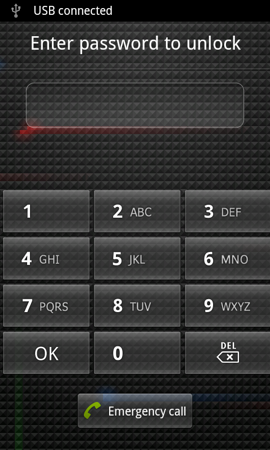 |
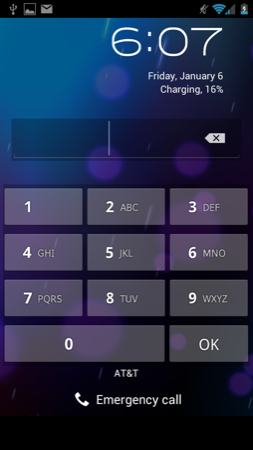 |
||
| Home |
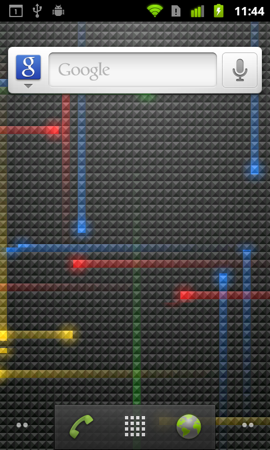 |
 |
||
| Launcher |
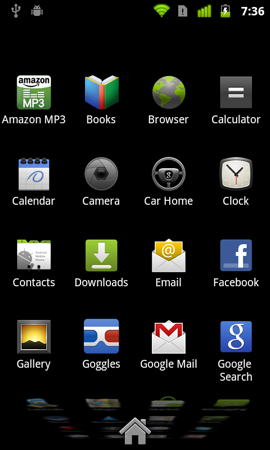 |
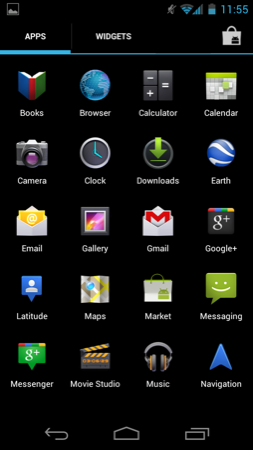 |
||
The New Contextual Menu Button
Play around with ICS for a little bit and you'll quickly pick up on a new UI element that appears inspired by Windows Phone:
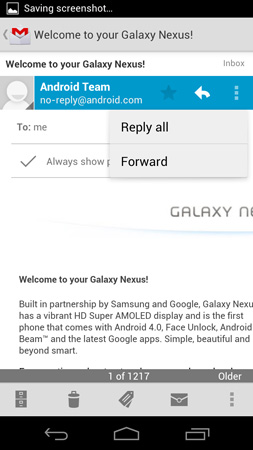
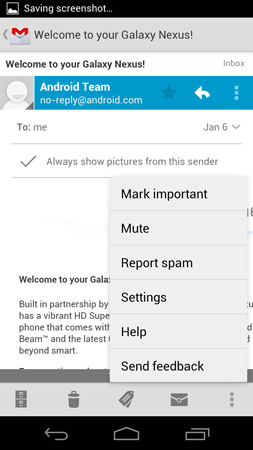
These vertically oriented ellipses will appear at either the top or bottom of an app and reveal additional menu options.
In Gingerbread you had the fixed Android menu button, but with that gone you have to rely on these contextual menu buttons to bring up additional actions. I'm honestly pleased with the move because all too often I'd forget to tap the menu button to see whether or not there were additional options in Gingerbread. ICS makes it very obvious when there's more you can do.
The Task Switcher
A cornerstone of any good operating system is a good task switcher. I still believe that webOS dealt with the concept of individual apps and switching between them better than any other mobile OS, but it looks like that platform is pretty much dead with little chance of making it into the top three mobile OSes.
Google and iOS haven't traditionally focused much on task switching, although both have provided support for it. In Gingerbread, you'd switch between apps by holding down the home button, which brought up a list of up to eight of your most recently used apps. Ice Cream Sandwich implements a drawer-style app switcher menu, first introduced in Honeycomb, activated by hitting the dedicated task switcher button:
| Gingerbread vs. Ice Cream Sandwich | ||||
| Gingerbread | Ice Cream Sandwich | |||
| Task Switcher |
 |
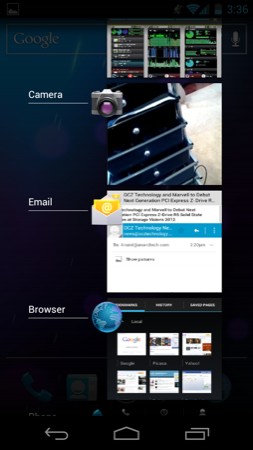 |
||
The Gingerbread method of switching may be quicker, but it's definitely not as useful as what ICS offers. For starters you can switch between more than just six apps in ICS. The most recent apps are located at the bottom of the list, the oldest at the top. You can also quit apps using the switcher by sliding them to the left or right. Doing so immediately frees up any memory the app was using, even if it was suspended.
Scrolling through the list of recent apps, like scrolling pretty much anywhere in ICS, is extremely smooth. The only real complaint I have here is that the task switcher takes far too long to draw initially. As I alluded to before, this is something that may get better with a faster SoC, particularly one with a faster GPU.
The Shade & Notifications
Notifications in ICS are still handled via the status bar at the very top of the screen and a pull down notification shade. The shade in ICS is partially transparent by default and once again, very smoothly animated. The network carrier string is included at the bottom of the shade rather than in the status bar at the top. You can clear notifications individually or hit the X to clear all of them.
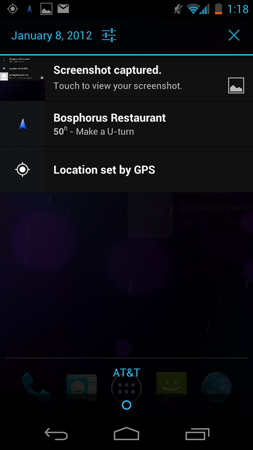
I am surprised Google didn't borrow the quick settings options its partners usually like to stick in the shade, but there is a link to the system settings panel at the top.
Screenshots
Android 4.x also finally enables the ability to take screenshots from within the OS. There's no necessity for OEMs to bake-in their own screenshot functionality and key press combination, no need to connect using USB and fire up ddms, and no need to root and install some application to make it work. Traditionally, those three have been the exclusive way to get screenshots taken on Android.
To take a screenshot in Android 4.x, simply hold volume down and the power/lock button at the same time. An animation plays, you get a notification, and the screenshot is saved (with a timestamped name in PNG format) in /pictures/screenshots as shown above.
I can't emphasize enough how important being able to take screenshots is for a platform in general. Without screenshots, users can only vicariously share a given OS when they're in direct contact with someone else. Being able to take screenshots without all the nonsense I've outlined above is part of what has made iOS so ubiquitous online - browse Reddit and count how many screenshots of SMS conversations (trite as they all are) are clearly from iOS versus Android. It's clear to me that Matias Duarte understands this, since webOS and even the Danger Hiptop since day 1 had the ability to take screenshots. Now Android 4.x finally joins the fray.










185 Comments
View All Comments
Brian Klug - Thursday, January 19, 2012 - link
Interesting. I originally picked S5K4E5 family as being the likely choice - as it's the BSI equivalent, and though that was what was inside until I decompiled/dug around inside the ducati-m3.bin file as noted in the review.You'll see numerous references to "S5K4E1G" and none for "S5K4E5" which is the BSI version. EG:
"CSI.COMPLEIO�¿F¿MSP.NEW_SENSOR�¿S5K4E1GA�¿F¿S5K6A1GX03�¿MSP.NEW_LENS�¿F¿VM149C�¿MSP.NEW_CSI�CSI2A�¿FCSI2B"
It could very well be BSI since they've x-rayed it.
-Brian
tom5 - Thursday, January 19, 2012 - link
Official Samsung site says SGS II has quad band 3G and Galaxy Nexus has penta-band 3G, so there's a difference in GSM connectivity:http://goo.gl/gvIWV
Stas - Thursday, January 19, 2012 - link
I appreciate the thoroughness in this review, Anand.Interesting, however, how I find so many things about the software completely irrelevant to someone who just can't leave things vanilla. Browser performance and features, launcher scrolling, screenshots, on-screen keyboard, etc. None of those things are in their original Android form on my phone (SGS2). Some issues have been addressed by Samsung, some by XDA developers, some by myself. As a result, I believe I have the perfect phone on the market (for me). Reading every section of this article, I kept finding myself thinking, "Heh, my phone doesn't have that problem," or, "Mine does that even better," or, "would suck to have that phone instead of my Galaxy."
I always thought advancement in tech = replacing devices sooner. However, after reading this review, I have no desire whatsoever to replace my current phone with the new flagship. I always get that feeling when I read a video card review, CPU review, SSD review, etc. But I feel like my phone lacks nothing, and I will stick with it for a long while. Customizing and tweaking software to your own taste, making it feel just right is the most important aspect of an electronic device that provides so much interaction. I guess that's why I almost feel handicapped on a stock Android phone or, especially, iPhone. The devices just feel so clunky and unrefined.
Thank you, if nothing else, for helping me see a different perspective on things :)
Lucian Armasu - Thursday, January 19, 2012 - link
1. Can you re-check and confirm if swiping tabs off in the task menu, actually KILLS the apps, or it just takes them off the list? Because I've heard before that it doesn't kill them.2. The battery tests, especially the Wi-Fi ones, were they done with 3G and LTE on?
silow675 - Thursday, January 19, 2012 - link
"At 720p, which happens to be the GN's native resolution, the OMAP 4460 is a bit faster than Tegra 2 but not significantly so. The more important thing to keep in mind is just how much faster Tegra 3's GPU is by comparison"I don't understand this remark. The chart that's posted for the 720p offscreen renders don't have a Tegra 2 device. In the RightWare charts the Galaxy Nexus scores much more than "a bit faster" than the Tegra 2 devices. And to my knowledge no Tegra 2 smartphones are offered at native 720p resolution.
I also checked the AT Bench database and couldn't find any Tegra 2 benchmarks to compare. Do you guys have some unposted numbers?
RobElk - Thursday, January 19, 2012 - link
You guys do a great job. Love the attention to detail in your review. Thanks.DrKlahn - Thursday, January 19, 2012 - link
I found this comment interesting. I have had the phone since launch day (VZW) and have yet to notice any lag hitting the virtual buttons. Perhaps I am just not as sensitive to it or some other process on your test phone is affecting it. I have got the phone to lag doing some very intensive tasks on occasion, but it's very infrequent. My chief complaint has been the volume which I remedied with a free app (Volume+ with the +2 setting). Otherwise I give the phone very high marks. I have no real desire to root or tinker with it yet, the stock experience is excellent.peokuk - Thursday, January 19, 2012 - link
for the font comparison, why not 'the quick brown fox jumps over the lazy dog'? using cat and jumped leaves out the letters 'g' and 's'...http://en.wikipedia.org/wiki/The_quick_brown_fox_j...
DanSmith - Thursday, January 19, 2012 - link
No one has actually said it yet so I will. Good review guys, in depth and informative as always.Thanks for your hard work.
Dan
DanSmith - Thursday, January 19, 2012 - link
Actually, someone already has! Seems the internet is not completely populated by haters. :)